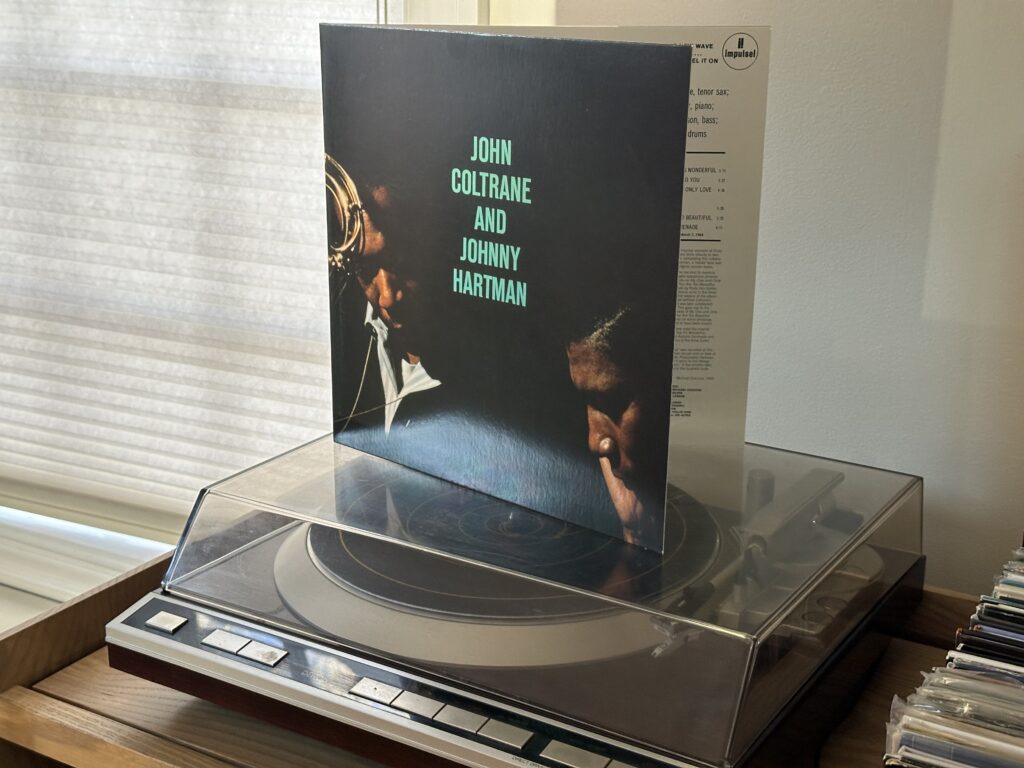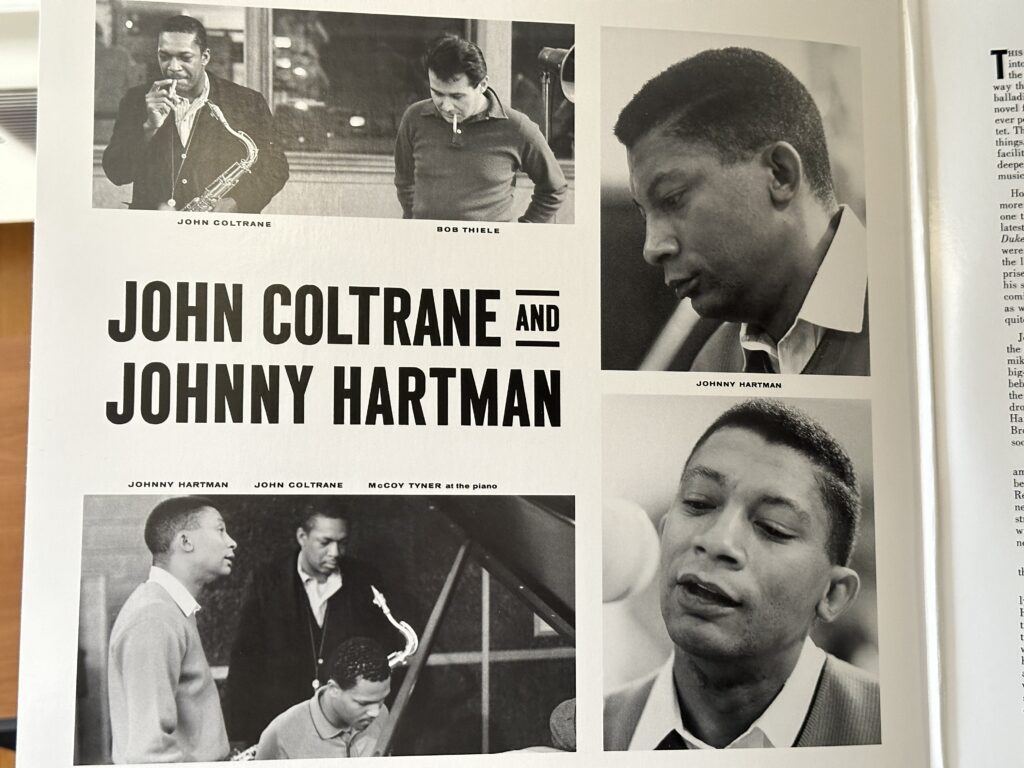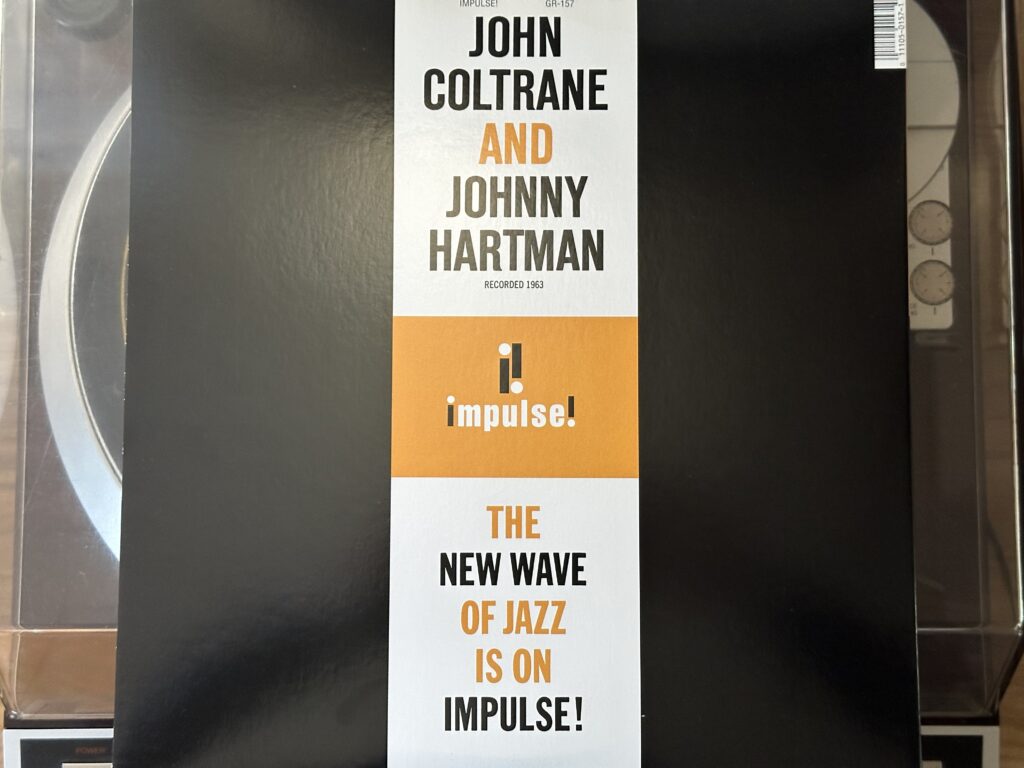
Album of the Week, February 17, 2024
When I was in high school, I knew that I wanted to have a tenor voice. My dad had a beautiful tenor voice that could ring the room. I listened to a lot of Sting, whose tenor voice seemed to dwell perpetually in a higher octave (and whose songs garnered me some much welcomed attention when I performed them). … And then l went to college and picked up John Coltrane and Johnny Hartman at Plan 9 Records, and decided maybe being a baritone was more desirable after all.
Coltrane and Hartman had both played in Dizzy Gillespie’s band in the late 1940s, but their time didn’t overlap; they shared a stage once in Harlem at the Apollo Theatre in 1950; but it’s still not known exactly how the singer came to Coltrane’s attention. But Trane has told us why he recorded with him. The Paris Review recounts a 1966 interview with the saxophonist, who told the interviewer, Frank Kofksky: “Johnny Hartman—a man that I’d had stuck up in my mind somewhere—I just felt something about him, you know, I don’t know what it was. And I liked his sound, I thought there was something there I had to hear, you know, so I looked him up and did that other one, see.”
That sound, incidentally, might be better thought of as crooning than jazz vocals. Colgate University professor Michael Coyle places Hartman in the crooning tradition, as a follower of Bing Crosby and Rudy Vallée, and points out his innovation was the ability to stretch the melodic line, introducing space and drama into the melodies. I dispute the point a bit—Hartman’s tone is solid and his control is completely impeccable—but there’s no doubt he’s a much more subtle singer than the performers who came before him.
That point is brought home in “They Say It’s Wonderful,” the first track on the album. After a brief introduction from McCoy Tyner, Hartman sings “They say that falling in love is wonderful.” But that quote is insufficient to convey the subtlety of his phrasing, as he leans on “say,” ever so briefly pauses after “that,” elongates “love,” and diminuendos ever so slightly on “wonderful” while still holding the note, creating a suspension on the seventh of the chord and making you hang on his words to hear what comes next. It’s a masterclass in vocal control, and it’s just the first phrase. Trane stays under Hartman’s line, providing accents at the end of lines but otherwise staying out of the way. When he takes a solo, he picks up some of the vocal inflections and phrasing of the singer, elaborating them a little with some of his characteristic flourishes but mostly staying in the pocket. While there are traces of the technically brilliant sheets of sound, they’re constrained within the boundaries of the melody, serving as accents rather than the main thrust of the sound. Hartman returns for a tag of the bridge and takes a breathtaking break in the rhythm, seeming to soar weightless over the band for a moment.
Hartman opens “Dedicated to You” with a simple declaration of the first quatrain of the melody, and Trane picks it up, playing the rest of the verse as a straight melody. At almost exactly the halfway point, Hartman picks it up seamlessly, singing it straight until the coda when he repeats the words “dedicated to you” as an out-of-time riff. It’s a sincere and simple, but not simple-minded performance. “My One and Only Love” is flipped around, with Trane taking the first verse with the quartet, taking a rubato measure to close the melody out, then inserting two bars in which the band seems to hover over a suspended fifth in the bass. Hartman enters after that moment of suspension and seems to restart all the clocks, taking the verse in time and stretching the meter in the final chorus just ever so slightly. The band returns to the suspended chords for a final two measures before resolving the tune.
“Lush Life” was reportedly a late addition to the track list; apparently Trane and Hartman were on their way to Rudy Van Gelder’s studio in a car when Nat King Cole’s version of the tune came on the radio, and Hartman decided on the spot to perform it. Trane of course had performed the tune years before, but you can definitely hear traces of Cole’s version in Hartman’s brisk introduction, which moves unsentimentally through the verse, accompanied only by Tyner, until he sings “washed away/by too many through the day” and holds “too” for an extra beat or two, accentuating the melancholy under the surface joys of the lush life. When the chorus begins, the rest of the quartet joins but stays in the background. Garrison’s bass spells out the roots of the chords and accentuates the changes with subtle arpeggios, and follows Hartman’s chromatic ascending scale on “those whose lives are lonely too”; Tyner continues the ascending scale after Hartman stops and Trane picks up the solo seamlessly, playing a breathless double-time through the melody until he gets to the final chorus, when Hartman rejoins to close it out. It’s a briefer version of the tune than Trane’s 1958 magnum opus but seems to hit all the high points.

Famously, Hartman claimed that the whole album was recorded in a single take, except “You Are Too Beautiful,” which had to be restarted when Elvin Jones dropped a brush. It’s a great story, if untrue (alternate takes are available for each track). The Rodgers and Hart tune gallops all over the octave, but Hartman makes it seem easy. Tyner gets the solo, playing through the tune as a syncopated stretto against Jones’ shuffle until the final four bars when he matches velocity with the main tune once again. In the reprise, Hartman’s careful use of legato is apparent in the first phrase, where he enters from above and uses a little melisma around the edges of the tune; his final phrase holds the supertonic just long enough for you to notice before he resolves.
The final track is, as far as I know, the only rumba that the classic Coltrane quartet ever recorded, so of course Trane deconstructs it in his solo. “Autumn Serenade” opens with the bass doubling Tyner, playing a rumba rhythm under Hartman. When Trane joins he turns the melody into a series of cascading sixteenth notes in groups of three, pausing between each and playing with the modal melody. This is the one place on the album where you can hear some of Trane’s searching runs, and the end of his solo feels as though it could keep going on that search forever, but he pulls back just enough. At the end, Hartman sings “serenade” and holds the top note while Trane plays a few more of the trios of sixteenth notes, as though turning away from the resolution to continue the search.
John Coltrane and Johnny Hartman was the third of Trane’s great ballads albums of the early 1960s, following Duke Ellington and John Coltrane and Ballads. Whatever the great saxophonist felt he had to prove to his critics or to himself, he appears to have done it with this album; the following recordings would return to some of the wilder searching we heard on Evenings at the Village Gate, but with a new sense of melodic core. We’ll hear one of the first outings of this next phase of Trane’s career next time.
You can listen to today’s album here:

